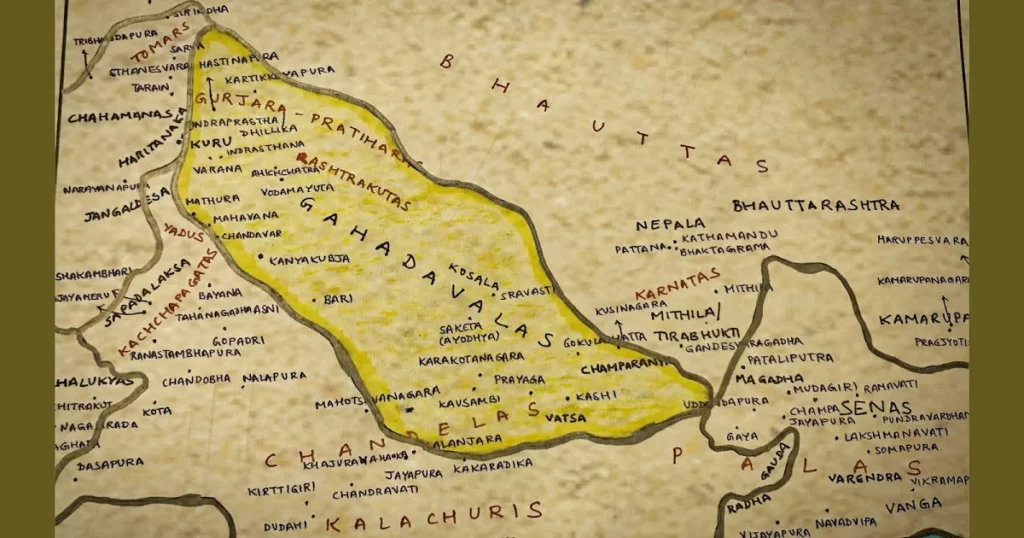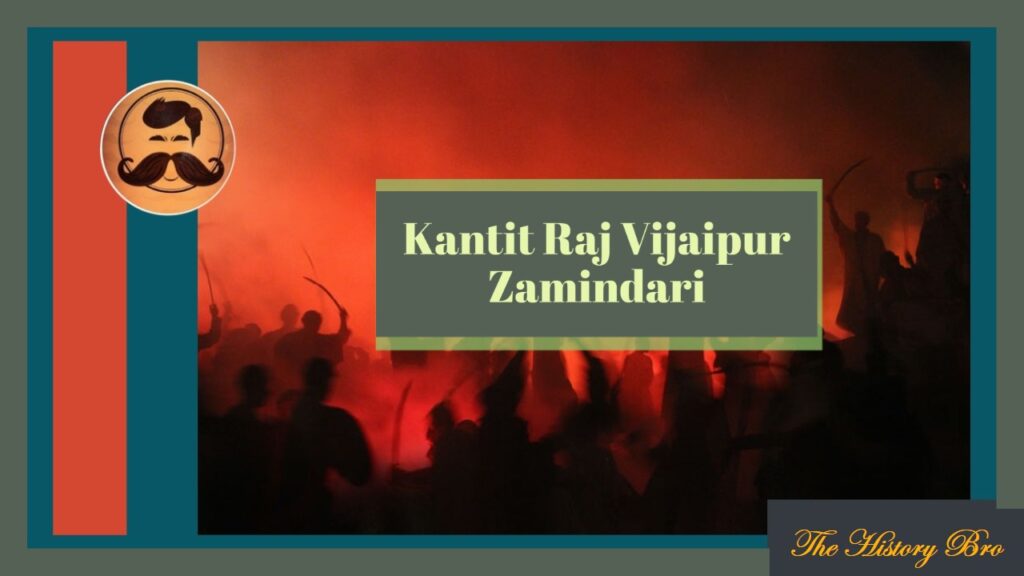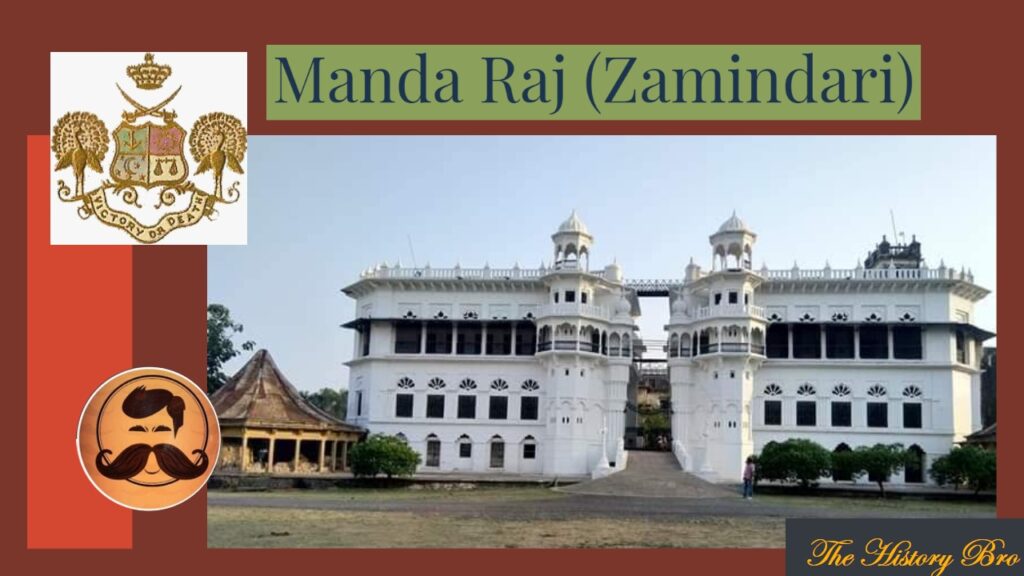Table of Contents
The Gahadvala or sometime spelled as Gadhwal is a Suryavanshi Kshatriya dynasty who ruled North India in the mid of 11th century till the mid of 13th century AD. The origin of this family is Banaras (Varanasi) and Oudh (Ayodhya) in Uttar Pradesh.
The Gahadavals of Kannauj ruled North India in the mid of 11th century till the mid of 13th century AD. The origin of this family is Banaras (Varanasi) and Oudh (Ayodhaya) in Uttar Pradesh. Later they settled in Kannauj which became the Political centre of India. The Gahadaval kingdom expanded till Delhi and moved eastward to Patna and Munjar areas of Bihar.
Rulers of Gahadavals dynasty
Yashovigraha: He was the founder of Gahadavals dynasty. A strong & a far-sighted ruler with well-planned policies. He was titled as ‘Maharaja Dhiraj’ and ‘Parambhattark’. He also established alliances with Muslims and paid tributes so as to secure the empire. His rule was mainly concentrated in establishing and securing the empire for future generations.
Mahichandra: He was son of Yasho Vigraha, who proved to be a weak ruler. Mahichandra could not rule independently as he didn’t possessed qualities of a strong king as his father. He was also famous by the name ‘Mahipala’ or ‘Mahitala’.
Chandradeva: He was the first independent king and was titled as ‘Parmeshwar’. By the period of Chandradeva, the Gahadavals had added Ayodhaya, Varanasi and Kannauj to their empire. Chandradeva won a fierce battle against Samanta Gopala and Panchala which increased his popularity. He protected the holy places of Kusika (Kannauj), Kashi and Dttara Kosala (Ayodhaya) from the invasions of Muslims. During his time the kingdom succeeded in spreading its wings and expanded till Khusi, North Kisala and Indraprastha.
Madanpala: Madanpala governed with the help of a committee of 5 people. He was successful to suppress the Muslim invasion that took place during his rule. He also won the battle against Rampala of Pala Dynasty. Usually being unhealthy he retired in 1109 AD and later on died in 1114 AD.
Govinchandra: He took over his father Madanpala in his lifetime only as an administrator but proved to be the most powerful ruler of this Dynasty. He faced invasion against Muslims but with his capabilities and intelligence he was able to win over all hardships. He was known as the ‘policy maker’ and a ‘brave’ ruler who saved Varanasi from the attack of Masud during his reign. He was known as ‘Hari Bhakt’ and worshiped in the temples of Varanasi. In the description of Sarnath, he is also inscribed as ‘Hari Bhagwan’. Rich religious developments took place in his time. Even the Muslims were allowed to follow their religion. He himself married a Buddhist girl ‘Kumardevi’. He expanded his state to the outh of the Yamuna River.
Vijaychandra: He joined as an administrator but during his time Muslims had become stronger. As a result dynasty had started to decline.
Jaichandra: He was a famous ruler but couldn’t get united with the other Hindu Rajput’s and lost parts of his kingdom in the hands of Muhammad Ghazni.
Harish Chandra: He was the last ruler of Ganvala Dynasty and son of Jaichandra.Much information is not available about his powers whether he was an independent ruler or not. But after his short tenure the Ganvala Dynasty came to end and Muslims took over the charge.

Foundation of the Gahadwar Dynasty at Kannauj
Chandradeva founded the Kannauj Gaharwar dynasty in 1090 A.D.. Chandradeva expanded the kingdom to include Delhi, Ayodhya, and Varanasi (modern Benares). During the rule of his successor, Govindachandra, from 1114–1154, the state of Gaharwar reached the pinnacle of its power, occupying much of present-day Uttar Pradesh and Bihar. Govindachandra moved his capital from Kannauj to Varanasi. His queen Kumaradevi was a devout Buddhist, and Govindachandra was a patron of both Hindu temples and Buddhist monasteries.
Expansion to Include Delhi
During the Rajput Raaj in India, the Gaharwar king, Chandradev, successfully commanded Delhi and annexed it to his State of Kannauj. Delhi was under Pratihara sovereignty at that time, who was being attacked by Rashtrakuta. Chandradev attacked both Rashtrakuta and Pratihara amid their battle with each other, defeated the two enemies now united against him, and took over the state of Delhi. After the dissolution of the Pratihara empire, Chandradev fought off repeated incursions, which laid down the foundation of the renaissance era in Delhi.
Gaharwar dynasty rule of the district is proved by the discovery at Kudarkot of a copper plate grant dated in the reign of Chandradeva. Chandradeva founded the Gaharwar dynasty at Kanyakubja after defeating a chief named Gopala of Tuar clan. His jurisdiction extended over nearly all of what is modern Uttar Pradesh including this district.
Chandradeva was succeeded by Madanpala, who ruled for a very short period. Madanpala was succeeded by his son Govindachandra. Two copper plate grants of Govindachandra, dated respectively Samvat 1161, or A. D. 1104, and Samvat 1174 or 1117 A. D. have been found in Bisahi, two miles north-east of Tehsil Bidhuna. Another copper plate grant of this king dated Samvat 1166 or A. D. 1109 was found at Rahan. Govindachandra seems to have wielded substantial power in the State while he was only a Yuvaraja, or Crown Prince. He defeated the invading Muslims prior to 1109 A.D., for the Rahan plate records that he “again and again by the play of his matchless fighting” compelled the Hammira (i.e. Amir) to “lay aside his enmity”. The Rahan plate further described Govindachandra as “terrific” in cleaving the frontal gloves of arrays of irresistible mighty large elephants from Gauda”, which shows that Govindachandra must have made some encroachments on Magadha. In short, Govindachandra made himself a power and revised the glories of this region.
Govindachandra was succeeded by his son Vijayachandra in 1155 A. D. Like his father, Vijayachandra also successfully faced Muslim aggressions. As Vijayachandra’ reign began, an unmistakable symptom of decline of the Gaharwar power manifested itself in the loss of Delhi, the Tuar rulers there stopped recognizing Vijaychandra as their sovereign and probably aligned with Chauhans of Ajmer.
The full significance of this loss was realised when, about a generation later, the Muslims attacked Delhi and occupied it, rendering the Gaharwar frontier defenceless. Vijayachandra was succeeded by his son, Jaichandra, in 1170 A. D. Jaichandra may be described as the last great king of the Gahadavala dynasty, whose power and extensive jurisdiction struck even Muslim historians. During the reign of Jaichandra, the Chauhans, from Ajmer, had annexed Delhi and were at this time bidding for supremacy in the North under Prathviraja ChauhanIII. The Chandellas were to the south there; at this time, their power was at its height. Additionally, there were repeated Muslim invasions of North-western India, which had already threatened the unity of India.
Prithviraj carried off Samyukta, daughter of Jaichandra. Samyukta’s elopement with Prithviraj III, heir to the rival Chauhan Rajput kingdom to the west, is the subject of many romantic tales, although this may have been the seed of the dissension between the kingdoms. Jaichand was destined to be the last Gaharwar king of Kannauj. He sought help from Muslims of North to invade Chauhans of Ajmer-Delhi. After fall of Delhi, the city of Kannauj was also attacked by Muhammad of Ghor in 1194; Jaichandra drowned in the Ganges fighting the battle; his kingdom was conquered and sacked by Muhammad’s armies. Some survivors, led by Jaichand’s son or grandson Siyaji (Shiv ji), fled west to the Marwar desert region of Rajasthan, where they established themselves as rulers in the early thirteenth century, founding the Rathore clan which ruled the princely state of Marwar or Jodhpur.
Collateral Branches of Gahadvala Dynasty
Chand Kings of Kumaon
Another branch escaped to the Kumaon hills, where 300 years later they usurped power in Kumaon by defeating the ruling Katyuri dynasty. The Chand kings mention Rathore as their kul The present king of Kumaon is Raja Mahendra Chand of Lamakhet (Pithoragarh), married to Rani Gita Chand of Rina and has three children (Rajkumari Aakanksha Chand, Rajkumari Mallika Chand, Rajkumar Aryan Chand)
Vijaypur-Kantit
Another grandson, Bijai Chand, fled to Kantit in the Mīrzāpur District and, overcoming the Bhar Rāja of that place, founded the family of the Gaharwār Rājas of Vijaipur-Kantit. All the other Gaharwārs trace their lineage to Benares or Vijaipur. Dahia kingdom is an extension of this line also.
Manda Kings
Gaharwar of Manda trace their line from a younger brother of Jaichandra of Kannauj. The last king was Raja Vishvanath Pratap Singh of Manda, prime – minister of India from 1989-91. Gaharwar, Rathore and Bundela share the Kashyap Gautra, and Gaharwar is considered the original bloodline for both Bundela and Rathore. The Gaharwar era in India was brief, but its impact has lasted through the era of renaissance in India.
Bundela
All the other Gaharwārs trace their lineage to Benares or Vijaipur. Another group of warriors that migrated southward from Kannauj came to occupy territory immediately west of Daiya, Manda, and Vijaipur. This line came to be known as Bundela and gave its name to the Bundelkhand that comprises parts of both current Madhya Pradesh and Uttar Pradesh.



Published Date :July 11, 2023 @ 6:31 pm


